No products in the cart.
NEWS
Cultivating Sweet Success: An Expert Guide to Growing Bountiful Strawberries
Growing your own strawberries is a truly rewarding journey into cultivating fresh, delicious food right at your fingertips. There’s nothing quite like plucking a perfectly ripe, sun-warmed strawberry directly from the plant and tasting its vibrant sweetness. While strawberries are often cited among the easier fruits for home gardeners, understanding a few key practices can significantly enhance your harvest, leading to more abundant and flavorful berries.
By following some fundamental guidelines for nurturing these versatile plants, you can look forward to enjoying a generous yield of strawberries spanning from late spring through the fall season. This guide, drawing on scientific principles and years of practical gardening experience from the Biogarden team, will walk you through everything you need to know.
Choosing the Right Strawberry Varieties for Your Garden
Your first step towards a successful strawberry patch is selecting the best varieties suited to your local climate and gardening goals. There are three primary types of strawberry plants widely grown:
- June-bearing strawberries: These produce a single, heavy crop over a few weeks in late spring or early summer. They are ideal if you want a large harvest for making preserves or freezing.
- Everbearing strawberries: These plants produce two to three harvests throughout the season – one in late spring/early summer, another in mid-summer, and often a third in the fall. While not a continuous yield, they provide berries over a longer period.
- Day-neutral strawberries: These varieties fruit consistently throughout the growing season as long as temperatures remain between 35°F and 85°F (1°C to 29°C). They produce a smaller number of berries per plant at any given time compared to June-bearers, but offer a steady supply.
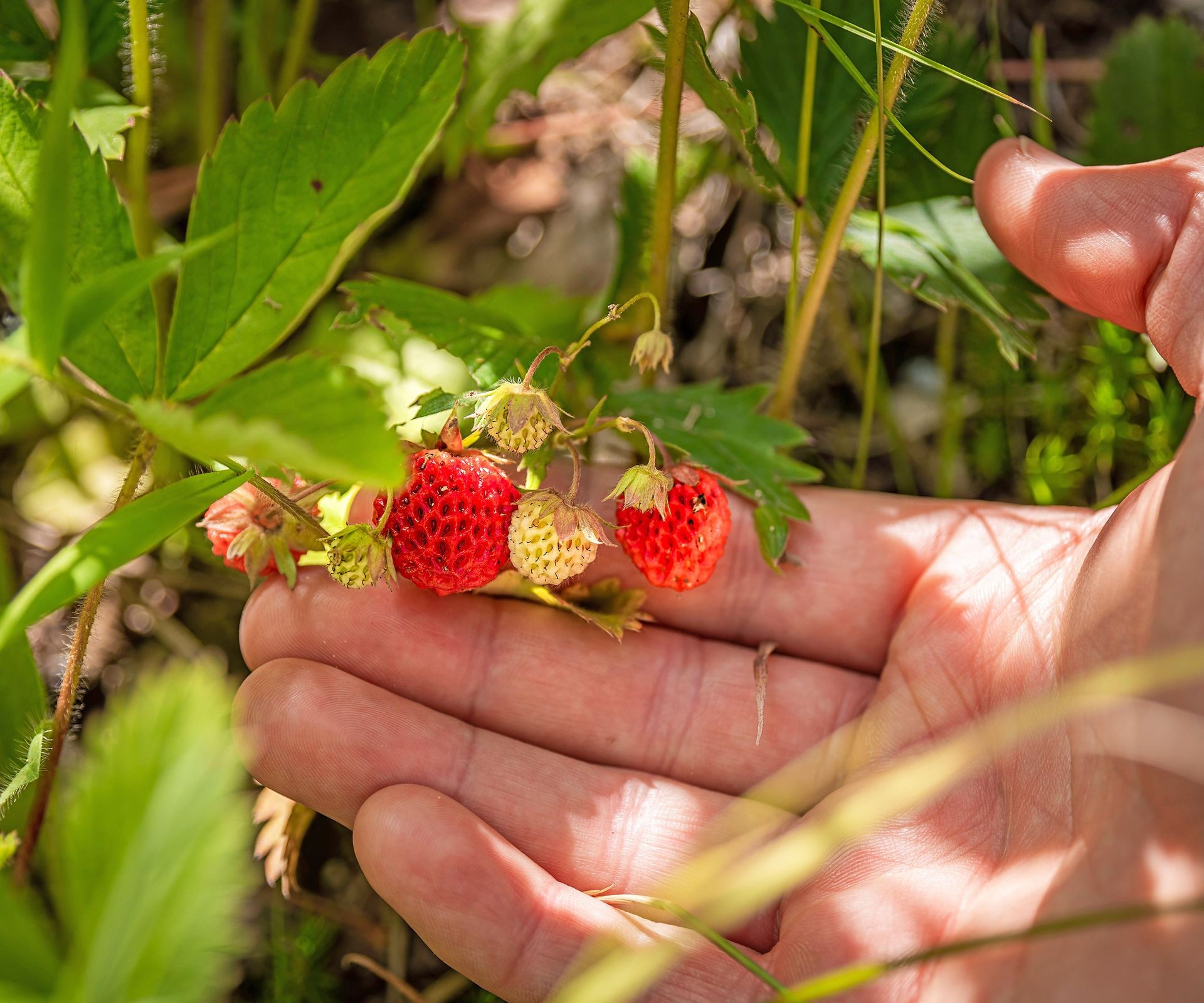 Hand holding delicate wild alpine strawberries harvested
Hand holding delicate wild alpine strawberries harvested
Beyond these common types, you can also explore wild strawberries (Fragaria vesca). These typically yield smaller, intensely sweet berries and are excellent for use as edible ground cover or garden edging. Alpine strawberries, a popular type of wild strawberry, are known for delicious varieties like ‘Mignonette’ and ‘Red Wonder’. Unlike most other strawberry types, alpine strawberries usually don’t produce runners and are typically grown from seed. To ensure a continuous supply of fresh berries from late spring well into fall, consider planting a mix of different varieties with varying cropping times and flavor profiles.
Starting Your Strawberry Patch: Plants or Seeds?
When planning how to establish your strawberry plants, starting from seed might seem appealing. However, based on efficiency and yield, the most common and often most successful approach is to plant young plug plants or bare-root strawberries, also known as runners.
Starting with young plants offers a significant head start, typically yielding fruit the summer following planting. Growing from seed, in contrast, is a slower process, usually taking at least a full year from sowing before the plants are mature enough to bear fruit. Strawberry plants are perennials and naturally produce runners, which are essentially ready-to-plant baby plants. This makes them particularly cost-effective over time, as you can propagate new plants from your existing ones.
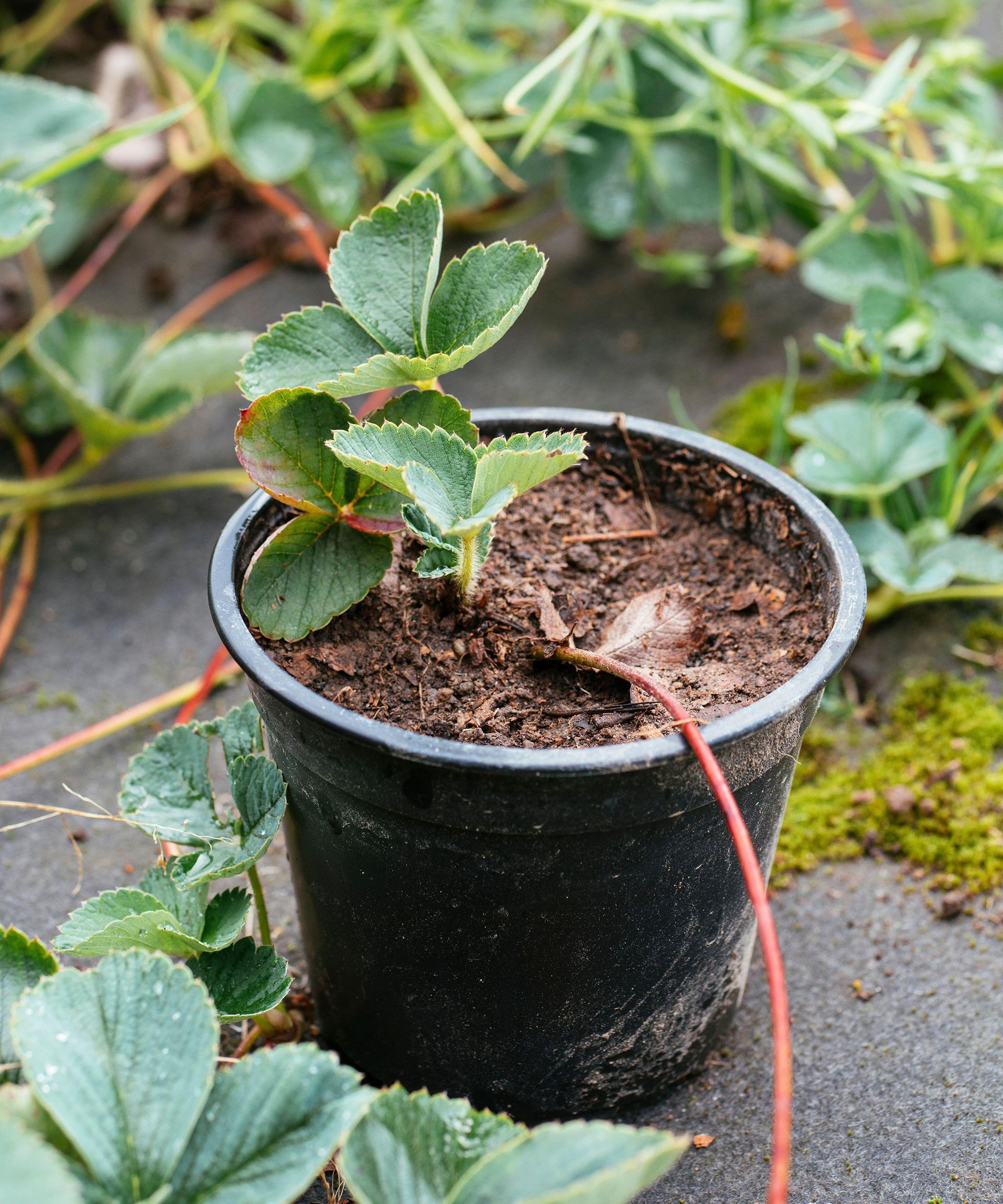 Newly planted strawberry runners establishing themselves in pots
Newly planted strawberry runners establishing themselves in pots
Growing Strawberries from Seeds
While starting from plants is faster, cultivating strawberries from seed remains a viable option, especially for wild or open-pollinated varieties like alpine strawberries, or if you simply enjoy the process. Remember that hybrid varieties grown from saved seed may not produce fruit true to the parent plant, offering an element of unpredictable but potentially exciting results for the experimental gardener.
To grow strawberries from seeds:
- Prepare a container with drainage holes using a seed-starting potting mix. This can be done in spring or fall.
- Sprinkle seeds thinly over the surface and gently press them in. Avoid covering them with more compost.
- Cover the container with plastic wrap or a dome to maintain humidity and place it on a bright windowsill or under a grow light for 12-14 hours daily.
- Germination can take up to six weeks. Once seedlings appear, begin feeding them every two weeks with a weakly diluted liquid fertilizer (half the recommended strength).
- As seedlings grow and become more robust, thin them out and transplant them into individual pots. At this stage, you can switch to full-strength fertilizer.
- Around 6 weeks later, start hardening off the seedlings by gradually exposing them to outdoor conditions. Begin with just a couple of hours in a sheltered location daily, slowly increasing the duration and moving them to a sunny spot.
- Once fully acclimatized, plant the seedlings in their final location – ideally an area receiving full sun with well-draining, slightly acidic soil. Mix some fertilizer into the soil before planting.
- Water thoroughly after planting and apply a layer of mulch, such as straw, around the plants. Mulch helps retain soil moisture and prevents developing fruits from resting directly on bare soil, which can cause rot.
Essential Steps for Planting Strawberries
Proper planting depth is crucial for strawberries. Plant them just deep enough so that the roots are covered by about ¼ inch (6mm) of soil, ensuring the crown (the central growing point where leaves emerge) remains exposed. The base of the crown should sit right at soil level. Immediately after planting, water your new plants generously and consider applying a balanced, all-purpose fertilizer to give them a strong start.
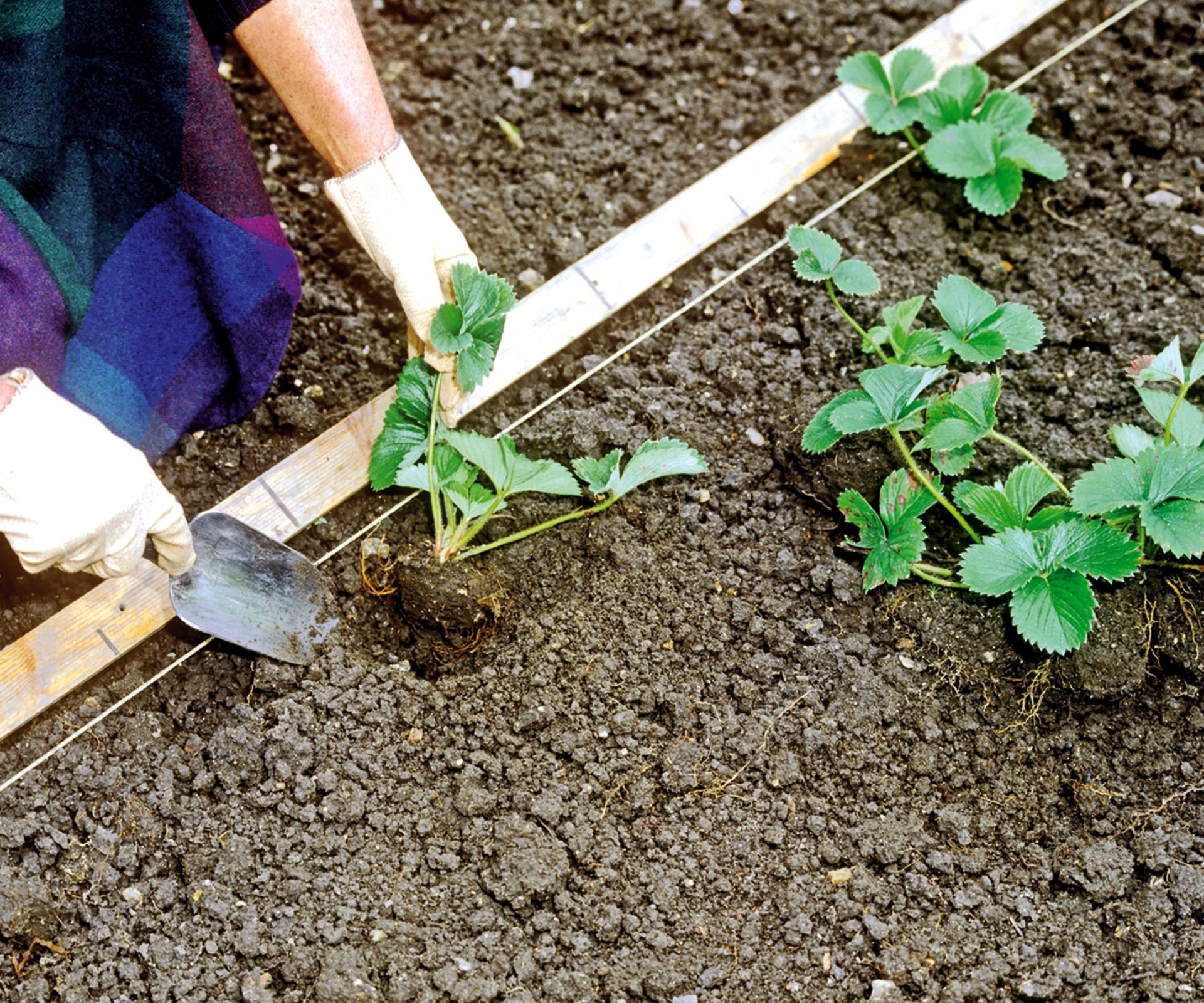 Carefully planting small strawberry plants into prepared garden soil
Carefully planting small strawberry plants into prepared garden soil
When to Plant Strawberries
The optimal time to plant strawberries for the best yield the following year is typically in late summer or early fall. This allows the plants ample time to establish a robust root system before winter. However, planting on a cloudy day in early spring (March or April), as soon as the soil is workable, is also successful. Spring planting gives the plants time to settle before the heat of summer arrives.
Where to Plant Strawberries
Strawberries require plenty of sunlight to produce a good crop. Choose a location that receives at least six or more hours of direct sun exposure daily. The amount of sun your plants receive directly impacts both the quantity and size of the berries you’ll harvest. Additionally, sufficient sun exposure in early spring can help protect blossoms from late frosts.
Strawberry Plant Spacing
Adequate spacing is important for air circulation and growth. Ideally, space strawberry plants 1.5 to 2 feet (40 to 60cm) apart. This provides ample room for growth and runner development. If space is limited, you can plant closer, down to 1 foot (31cm), but be prepared to provide more diligent watering and fertilization. If planting in rows, leave 3 to 4 feet (about 1m) between rows.
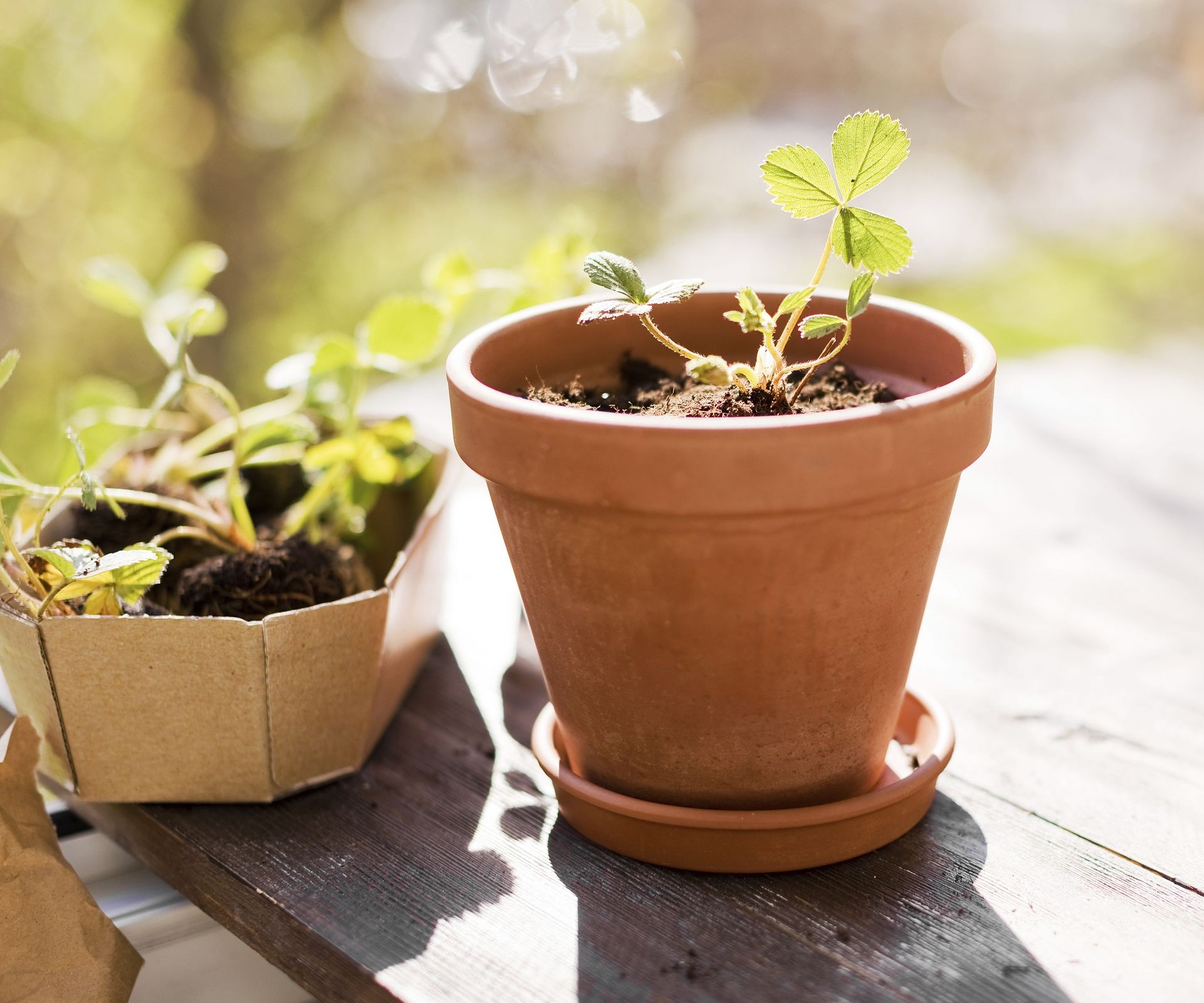 Tray of healthy strawberry seedlings ready for transplanting
Tray of healthy strawberry seedlings ready for transplanting
Mastering Strawberry Watering
One area where new strawberry growers sometimes face confusion is watering. Because strawberry plants have relatively shallow root systems, consistent moisture is vital. While rainfall can provide some of their water needs, most gardeners will find supplemental watering necessary, especially during dry periods.
The key is to water the soil directly, not the foliage. Wet leaves can encourage fungal diseases. Techniques like drip irrigation or soaker hoses placed at the base of the plants are highly effective for delivering water precisely where it’s needed.
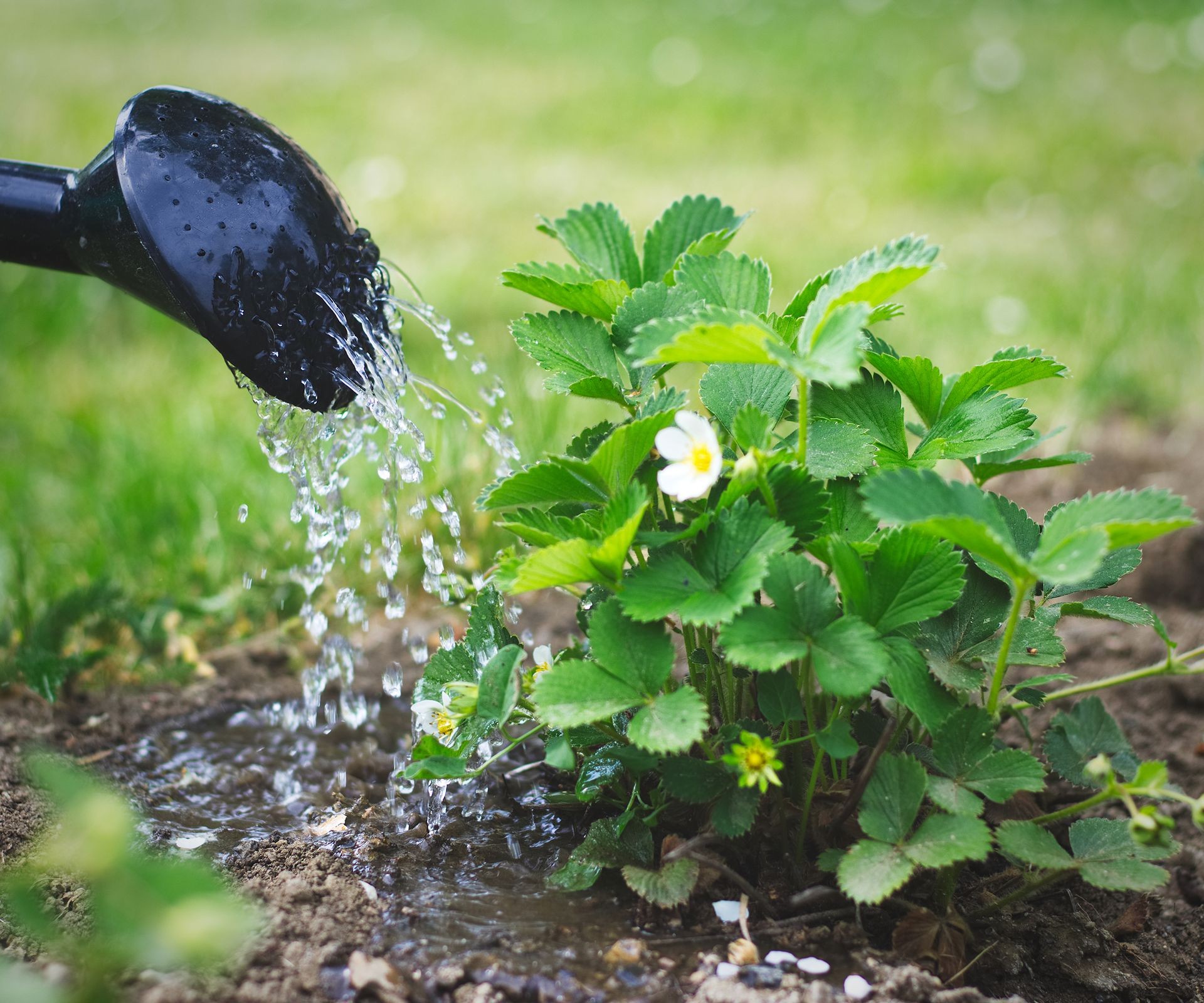 Using a watering can to gently water strawberry plants
Using a watering can to gently water strawberry plants
How Often to Water Strawberries?
As a general rule, strawberries need watering at least once a week. However, this frequency must increase during dry spells or periods of high heat. In scorching conditions, you may even find yourself watering daily. Rather than sticking to a strict schedule, it’s best to check the soil moisture. Insert your finger about two inches deep into the soil near the plants. If it feels dry at that depth, it’s time to water. If it feels moist, hold off. Overwatering is a common issue and can quickly lead to root rot.
How Much Water Do Strawberries Need?
Whether from rain or manual watering, strawberries require approximately 1 to 2 inches (2.5 to 5cm) of water per week. During hot, dry weather, you might increase this amount slightly, delivering about 2.5 inches (6cm) each time you water. Regular soil moisture checks are essential to gauge the plant’s needs.
Nourishing Your Plants: Fertilizing Strawberries
Providing adequate nutrients through fertilization is crucial for achieving a prolific harvest of large, juicy strawberries. Strawberry plants primarily require nitrogen to support healthy green growth, particularly in the spring when they emerge and again in late fall. Incorporating compost or well-rotted manure into the soil before planting is an excellent way to provide this initial nitrogen boost and improve overall soil fertility.
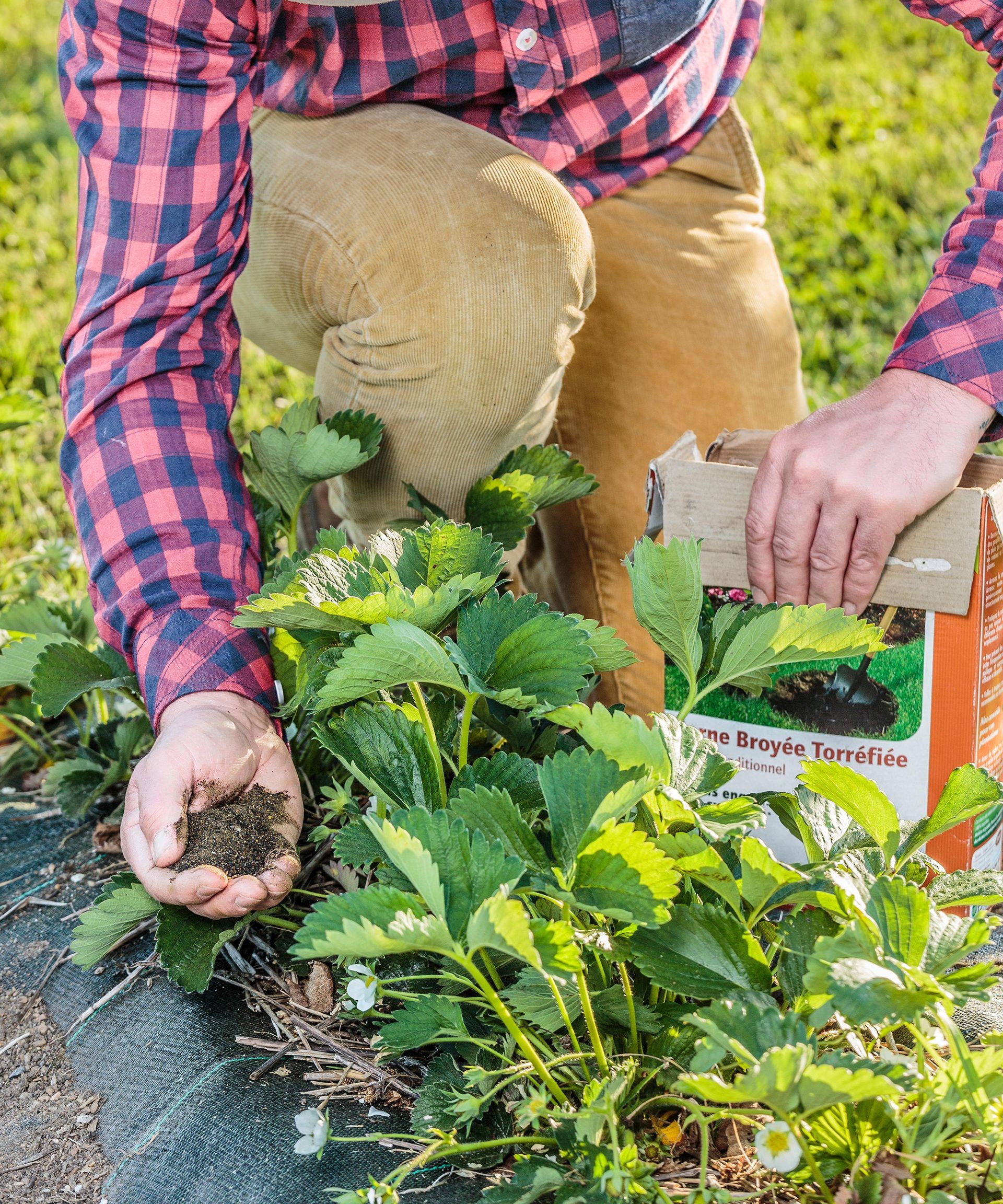 Applying granular fertilizer around the base of strawberry plants
Applying granular fertilizer around the base of strawberry plants
When to Fertilize Strawberries
The first feeding should occur when you observe new growth emerging from your strawberry plants, typically in early to mid-spring. This provides essential nutrients as they begin their active growth phase. The second critical time to fertilize is after the plants have finished fruiting for the season. This late-season feeding helps the plants recover from the energy expenditure of producing berries, encourages robust runner development, and allows them to store energy reserves crucial for developing next year’s blossoms and a bumper crop.
How to Fertilize Strawberries
A common approach is to use a balanced commercial fertilizer, such as one with a 10-10-10 NPK ratio (equal parts Nitrogen, Phosphorus, and Potassium). A general guideline is to apply about 1 pound (454g) of this type of fertilizer per 20-foot (6m) row of strawberries. Apply the fertilizer around the base of each plant, being careful not to let it touch the crown directly, and water it in thoroughly. For those preferring organic methods, excellent alternatives include blood meal, fish meal, or alfalfa meal, which provide nutrients in a slower-release form.
The Importance of Mulching for Strawberry Health
Mulching is a highly beneficial practice for strawberry plants, ideally performed once or twice a year. In spring, applying a thin layer of organic mulch, such as straw (about 1 inch or 2.5cm deep), around the base of the plants helps conserve soil moisture, suppress weeds, and importantly, keeps the developing fruits off the bare soil, significantly reducing the risk of rot and disease. Other materials like cardboard or felt matting can also serve this purpose.
 Mulching around young strawberry plants with a layer of straw
Mulching around young strawberry plants with a layer of straw
In regions with cold winters, winter mulching is essential for protecting strawberry plants from extreme temperatures and frost heave. Apply a thicker layer of mulch (several inches) over the entire patch in late fall or early winter. Wait until the foliage has flattened after the first hard autumn frost; exposure to this initial frost can actually improve the following year’s productivity. Remember to remove this protective winter layer in early spring before new growth begins, then apply the thin spring layer underneath the foliage as described above.
Protecting Your Precious Crop
Once your strawberries begin to ripen, they become a prime target for hungry birds. Implementing protective measures is vital to ensure you get to enjoy your harvest.
Protecting Strawberries from Birds
As soon as you see any green berries starting to blush red, it’s time to cover your strawberry plants with netting. The netting should be draped over the plants and secured around the edges to prevent birds from getting underneath. Simple supports like stakes or hoops can keep the net elevated above the plants. Ensure the netting is easy to lift or roll back for watering, maintenance, and harvesting.
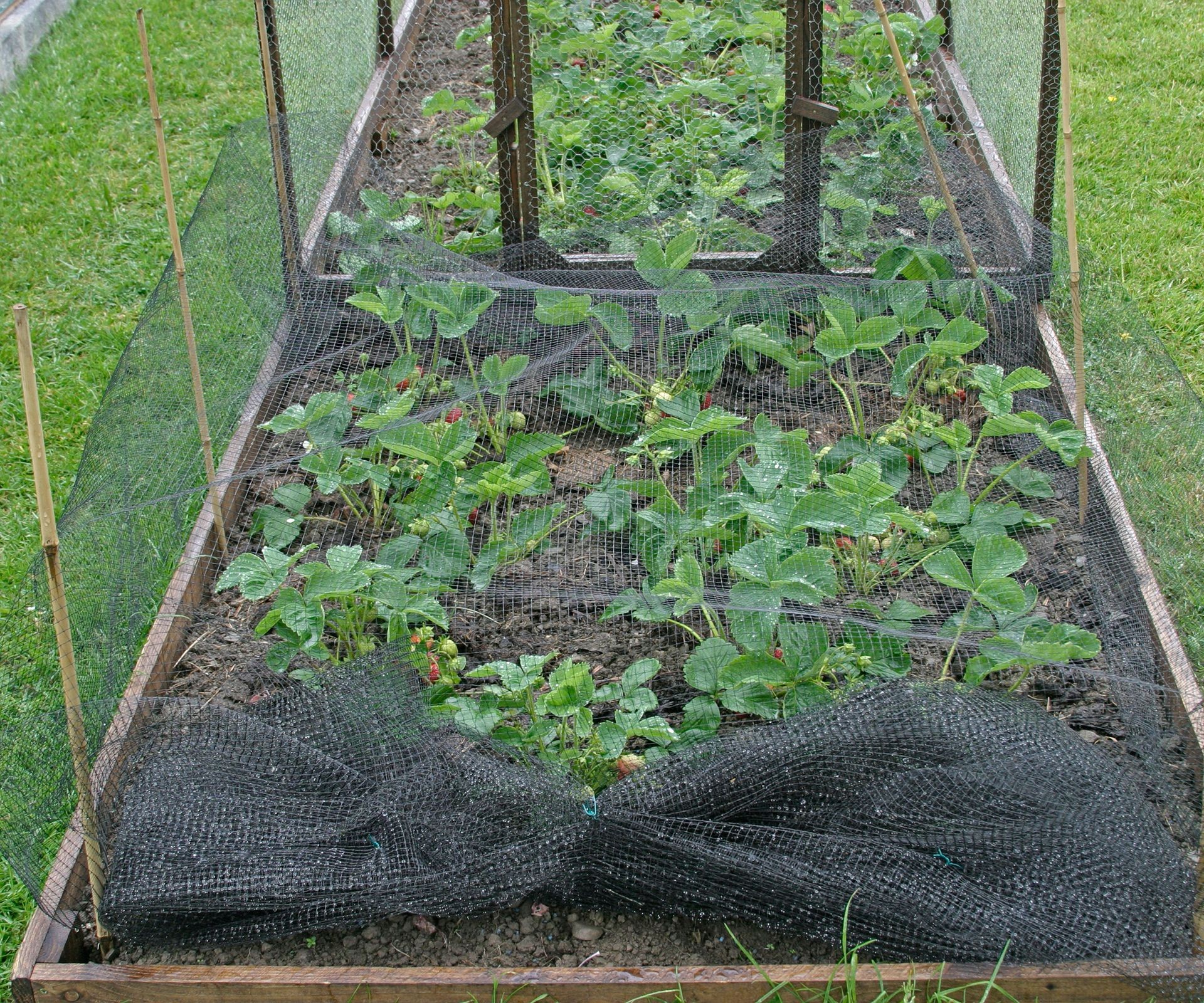 Protective netting covering strawberry plants to deter birds
Protective netting covering strawberry plants to deter birds
Dealing with Pests and Diseases
Encountering pests or diseases can be disheartening, but identifying and addressing issues promptly can often save your harvest. Preventing problems is always easier than curing them. Clever companion planting, as discussed later, can be a first line of defense by attracting beneficial insects or deterring pests. If pest issues arise, explore organic control solutions before resorting to chemical treatments. Common problems like powdery mildew, slugs, or certain insects can severely impact yield or even cause plant death if not managed. Regular inspection of your plants helps catch issues early.
Knowing When and How to Harvest Strawberries
Timing is everything when picking strawberries. They should be harvested when they are fully red across the entire berry, as they will not continue to ripen significantly after being picked. Since berries ripen at different rates, check your plants every two to three days during the harvest season. The best time to pick is in the morning after any dew has dried but before the heat of the day builds up, as the berries are cool and firm.
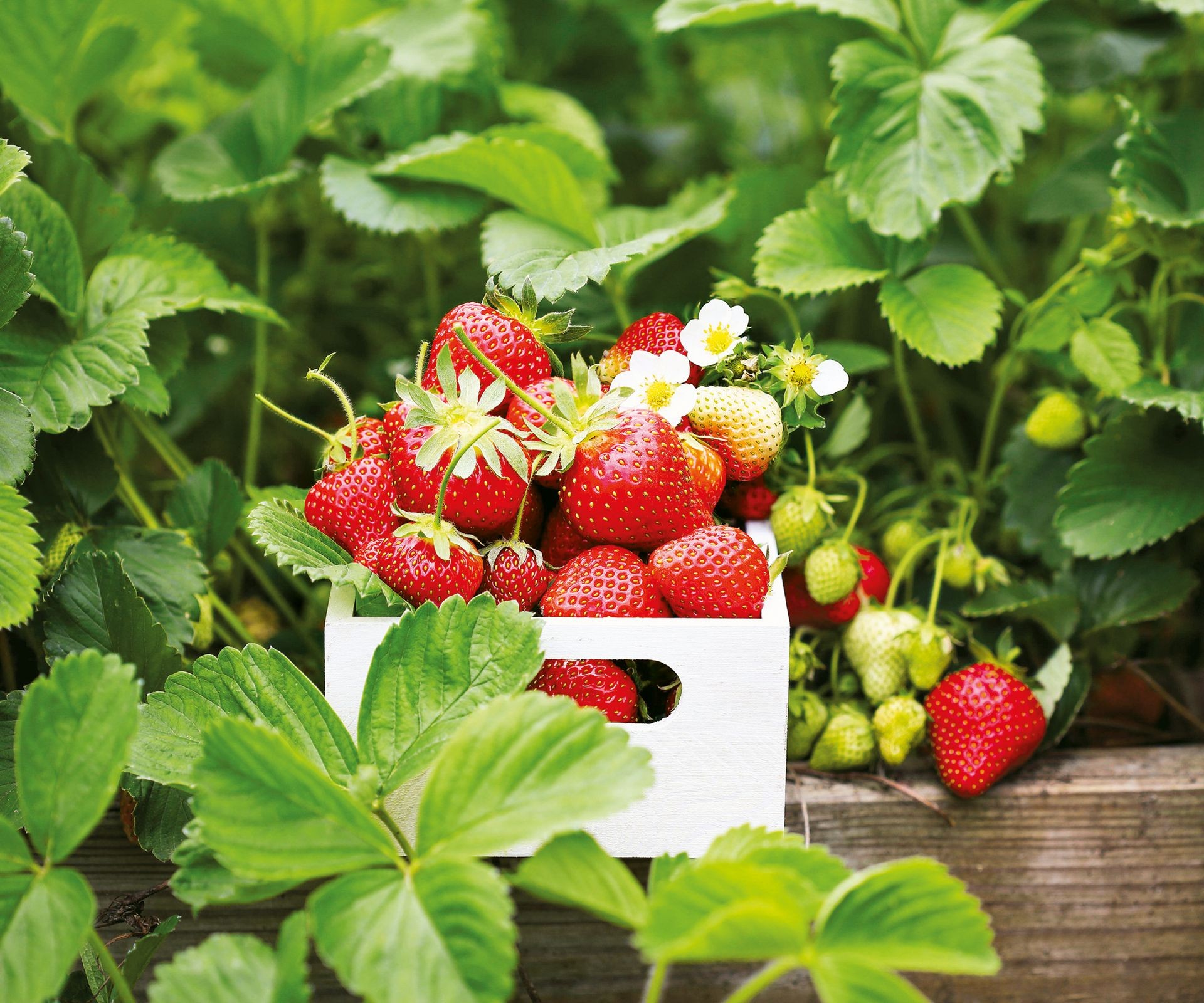 Basket overflowing with freshly harvested ripe red strawberries
Basket overflowing with freshly harvested ripe red strawberries
When harvesting, leave about a quarter-inch of stem attached to the berry. This helps the fruit last longer and prevents bruising. The most effective technique is to hold the stem gently between your forefinger and thumb and give a gentle tug and twist. Handle the delicate fruits carefully. Ideally, enjoy your fresh strawberries the same day. They can be stored in the refrigerator for about three days, ideally in a single layer on a paper towel-lined container. If you find yourself with an abundant yield, there are countless delicious ways to use fresh strawberries from your garden, from jams and pies to smoothies and salads.
Post-Harvest Care: Pruning Your Plants
Once your strawberry plants have finished producing their last berries of the season, it’s time for essential post-harvest maintenance, specifically pruning. Cut back the foliage on your June-bearing plants to about 3 to 4 inches (7.5 to 10cm) above the crown. This pruning directs the plant’s energy towards strengthening its root system and developing new growth that will support next year’s fruit production.
Simultaneously, it’s a good time to thin out older, less productive plants from the patch. Strawberry plants are most productive in their first three years. Replacing older plants with vigorous new runners propagated from healthier parent plants helps maintain the overall productivity of your strawberry bed. Always use sharp, sterilized hand pruners to make clean cuts and minimize the risk of damaging the plants or spreading diseases.
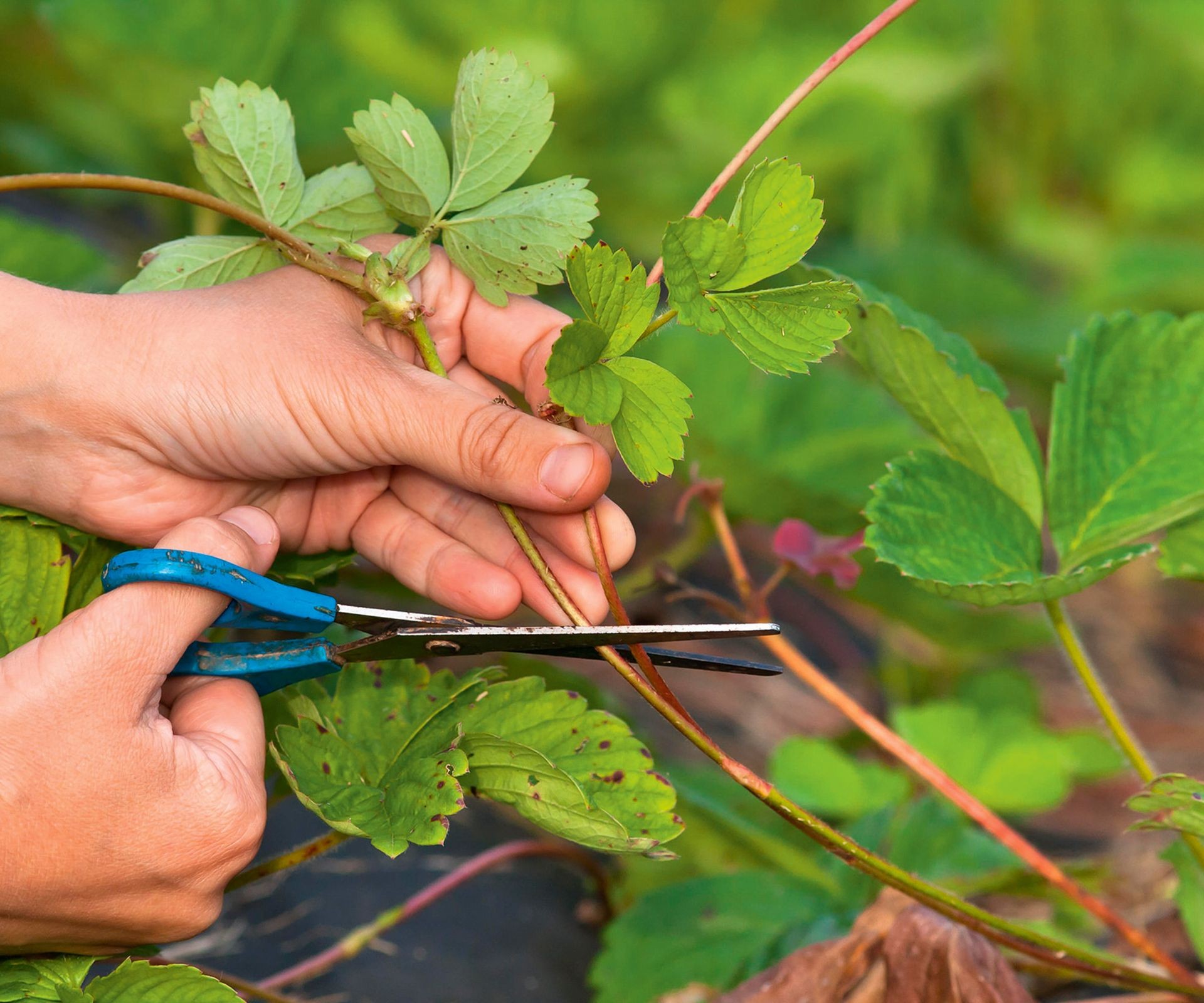 Using hand pruners to carefully cut off strawberry plant runners
Using hand pruners to carefully cut off strawberry plant runners
Propagating New Plants from Runners
One of the most rewarding aspects of growing strawberries is how easily they propagate themselves, especially through runners. Propagating strawberries from runners is simple and provides a continuous supply of free plants for years to come. Each healthy strawberry plant typically sends out several runners – long stems that develop small plantlets (baby plants) along their length.
In late summer or early fall, after the fruiting season has ended, you can gently separate these runners from the main plant. Select the runners closest to the parent plant for propagation, as these are usually the most vigorous. Runners further away can be removed to conserve the parent plant’s energy. These plantlets can be left in place to root and form new plants in situ, or for better results, they can be carefully dug up and transferred to individual pots filled with potting mix to develop stronger root systems before being planted out in their final location the following spring. You’ll likely have more than enough new plants to expand your patch or share with fellow gardeners!
Boosting Your Patch with Companion Planting
Companion planting is an age-old agricultural practice involving strategically placing different types of plants near each other to provide mutual benefits. For strawberries, companion plants can offer several advantages: deterring pests, attracting beneficial insects (like pollinators), providing shade, serving as living mulch, or even potentially enhancing flavor.
Consider what to plant alongside your strawberries. For instance, borage is said to improve strawberry flavor and attract pollinators. Legumes can add nitrogen to the soil. Thyme, sage, and mint may help deter certain pests (though mint can be invasive, so planting it in a container nearby is often wise). Onions, garlic, and chives can help deter common fungal diseases and some insect pests.
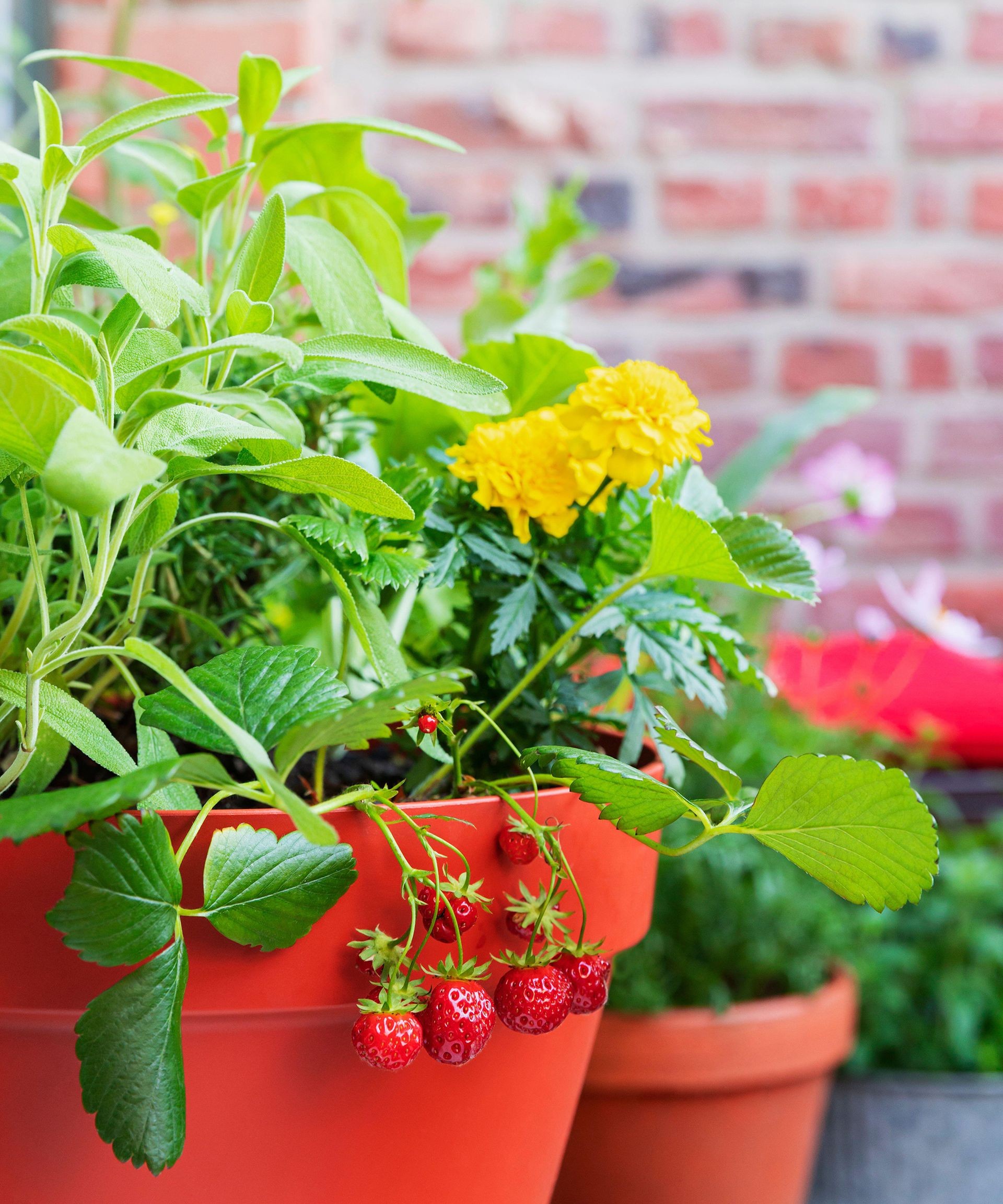 Strawberries growing happily in a container with other companion plants on a balcony
Strawberries growing happily in a container with other companion plants on a balcony
Growing Strawberries in Limited Spaces: Containers and Indoors
Strawberries are exceptionally well-suited for container gardening, making them a great choice for patios, balconies, or small yards. They thrive in pots, hanging baskets, or even specialized strawberry planters, provided they receive sufficient sunlight.
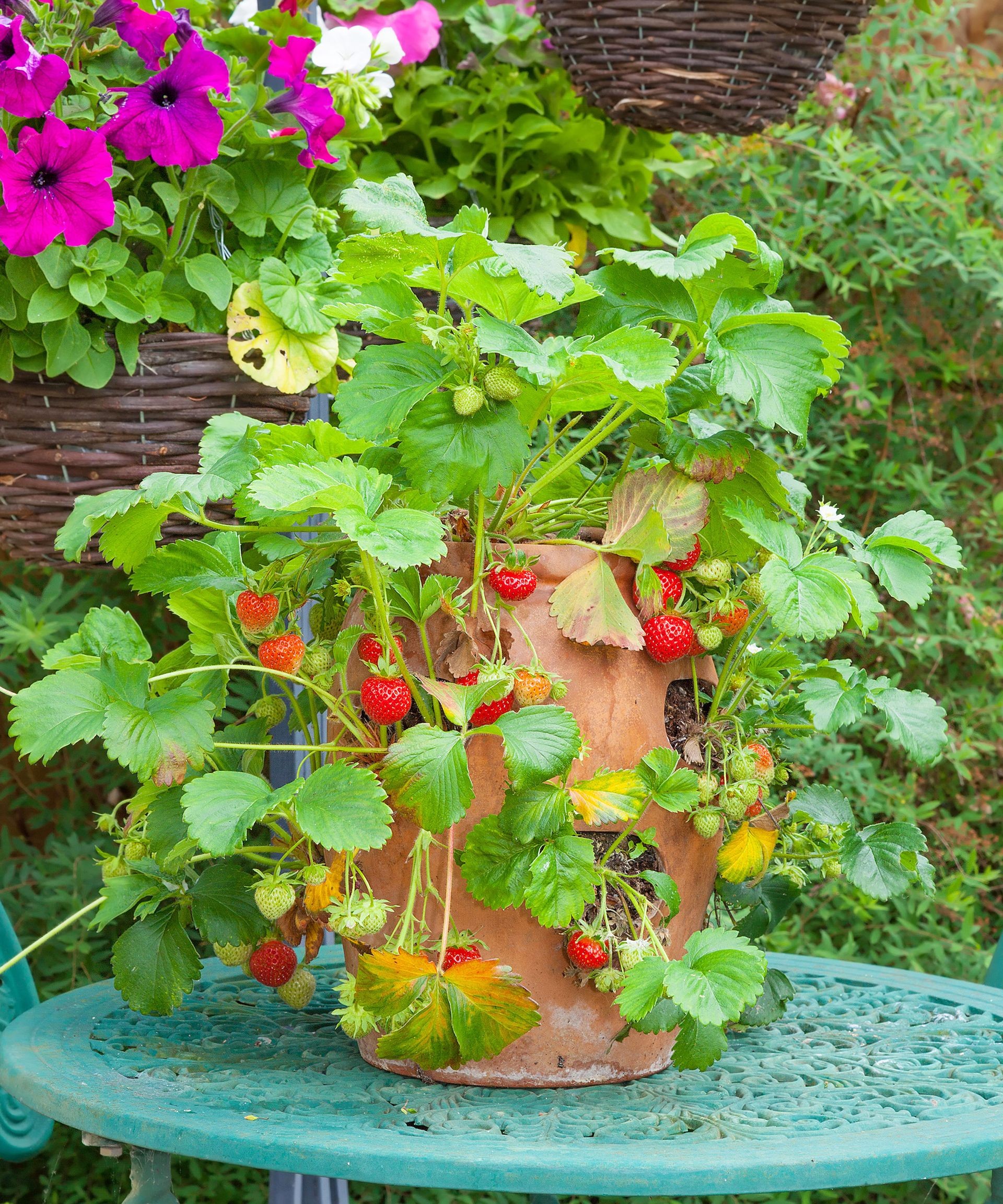 Strawberries flourishing in a specialized tiered planter with side holes
Strawberries flourishing in a specialized tiered planter with side holes
Growing Strawberries in Containers
When growing strawberries in containers, choosing a tiered planter with side pockets is highly effective, as it allows the berries to hang freely, reducing contact with moist soil. However, any container with adequate drainage holes will work, including grow bags. Good drainage is paramount to prevent waterlogged soil, which leads to root issues. For a tiered pot, you’ll typically need one plant per side pocket and three or four for the top. Other containers can accommodate three to four plants depending on size. Improve drainage by adding a layer of broken pottery shards or gravel at the base before filling the container with a growing medium. Use a high-quality potting mix designed for fruits and vegetables, or create your own blend using potting soil, compost, and soilless media like perlite or vermiculite to enhance drainage and aeration. Mix in a slow-release fertilizer at planting time. Position your container in a sunny location and water thoroughly. Remember that container-grown strawberries dry out faster than those in the ground and will require more frequent watering and potentially more regular fertilization.
Growing Strawberries Indoors
Growing strawberries indoors is a fantastic option if you lack outdoor space or live in a climate with harsh weather extremes. The main challenge for indoor growing is ensuring the plants receive enough light; they still need at least six hours of bright light daily. If a sunny windowsill doesn’t suffice, investing in a grow light is essential. Since indoor strawberries are usually in smaller pots, check the soil moisture frequently, often daily, to prevent them from drying out.
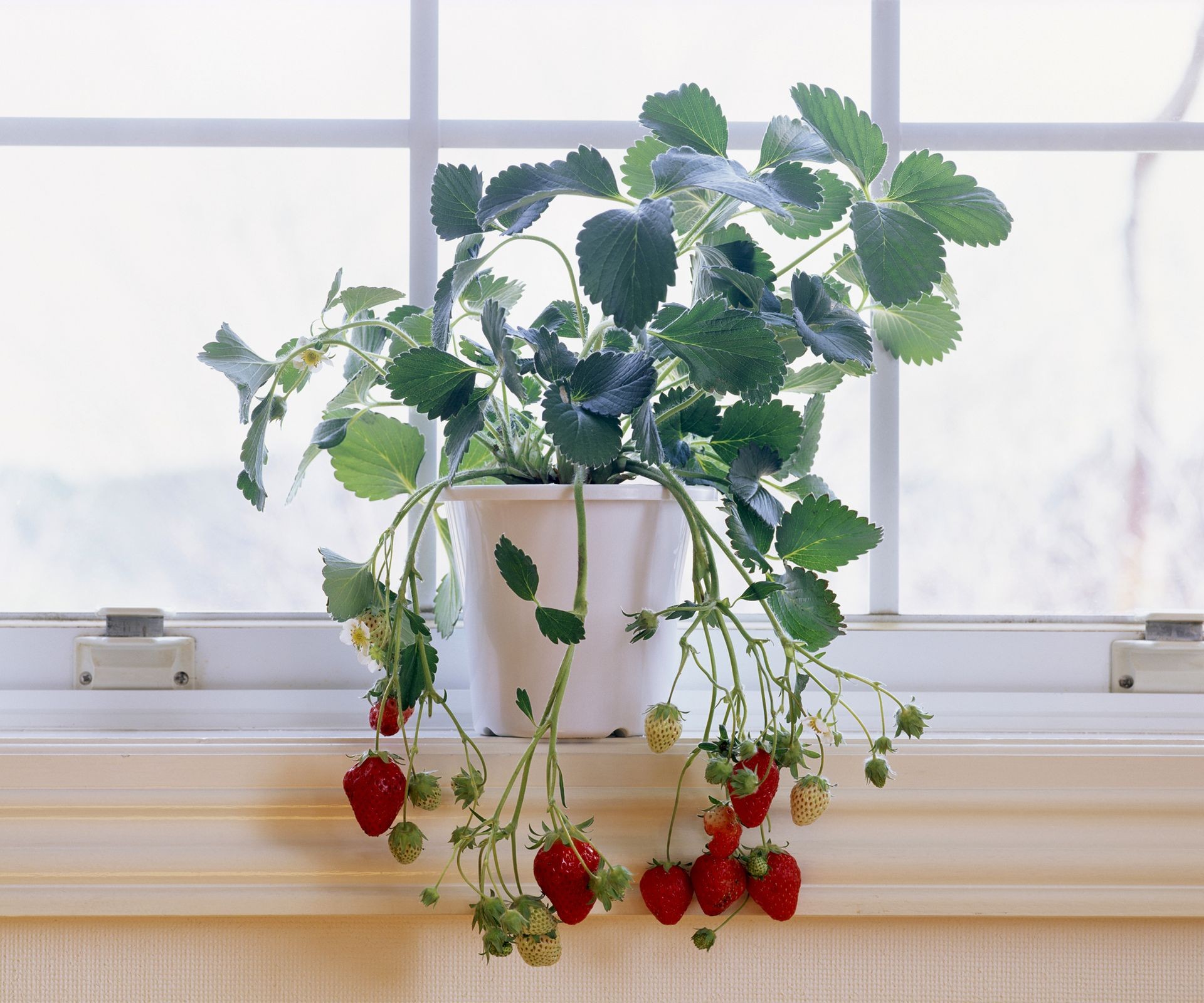 A healthy strawberry plant growing on a sunny windowsill indoors
A healthy strawberry plant growing on a sunny windowsill indoors
Troubleshooting Common Strawberry Issues
It can be disheartening when your strawberry plants show signs of distress. However, many problems can be resolved with prompt diagnosis and action, potentially saving your harvest. Implementing preventative measures, such as good cultural practices and companion planting, is your best defense. If pests or diseases appear, identify the issue and consider organic control methods as your first option. Common problems like powdery mildew, leaf spot, aphids, or slugs can severely impact plant health and fruit production if not addressed swiftly.
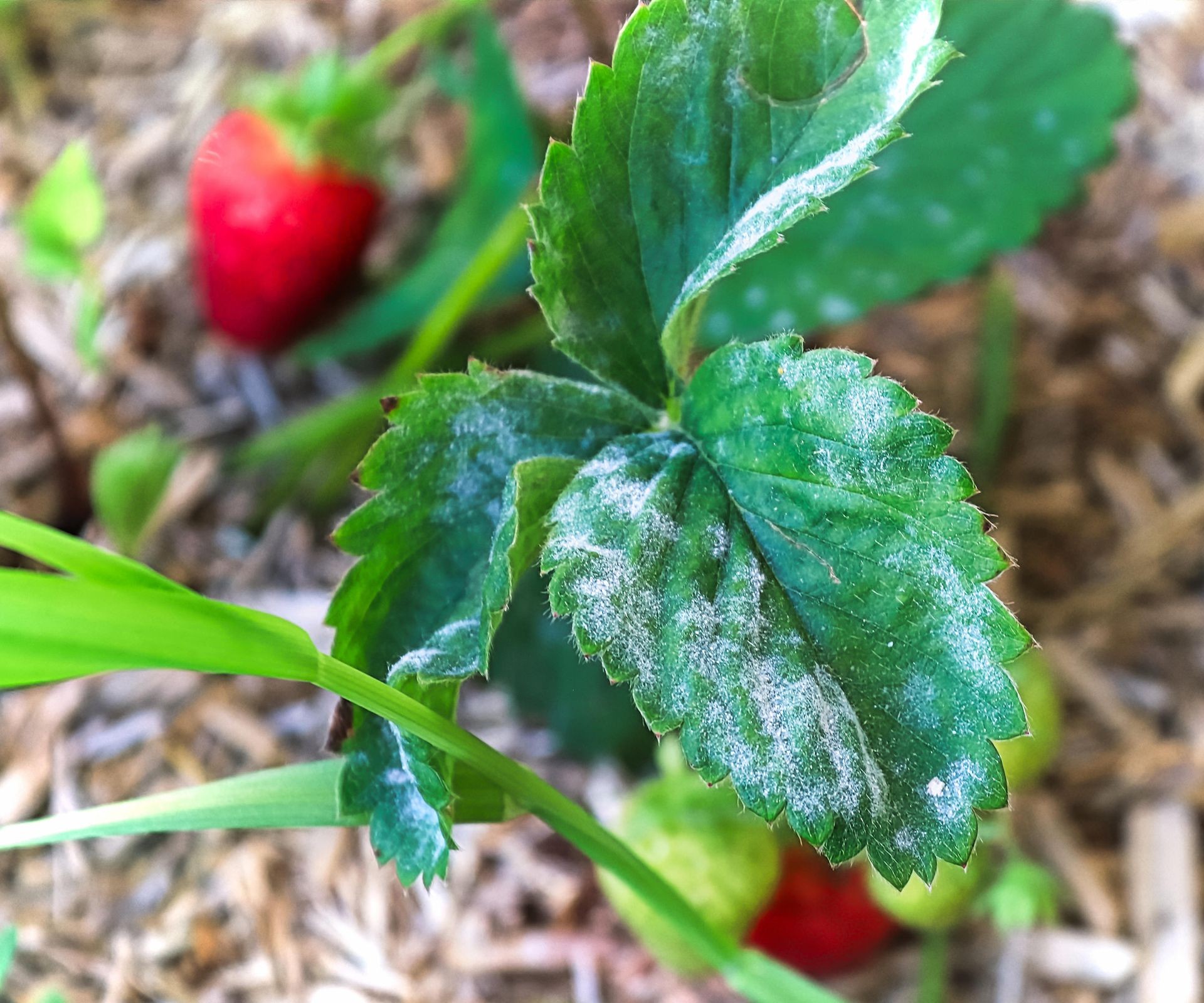 Close-up view of powdery mildew affecting a strawberry plant leaf
Close-up view of powdery mildew affecting a strawberry plant leaf
Frequently Asked Questions About Growing Strawberries
Based on our experience and common questions from gardeners, here are answers to some frequently asked questions about growing strawberries:
How many strawberry plants per person are recommended?
For a steady supply of fresh berries for snacking, about six plants per person is a good starting point. This quantity allows for a satisfying yield without requiring vast space. If your ambitions include making preserves, baking, or freezing, you’ll need to increase the number of plants significantly. On average, a healthy, mature plant can yield about a quart of strawberries per year, though this will be spread out over the harvest season.
Are strawberry plants perennials?
Yes, strawberry plants are perennials, meaning they live for more than two years. However, their peak productivity typically lasts for about three years. After this period, yield often declines. It’s recommended to replace these older plants with new, vigorous runners propagated from your healthier parent plants to maintain high production levels in your patch.
Do strawberry plants require full sun?
Most commonly grown strawberry varieties thrive in full sun, requiring a minimum of six hours of direct sunlight daily for optimal fruit production. Sunlight is directly correlated with the size and sweetness of the berries and the abundance of the harvest. However, there are some shade-tolerant varieties, often wild strawberries, that can produce acceptably in less sunny conditions, though yields may be smaller.
How long does it take for strawberries to grow and produce fruit?
When planting young plug or bare-root plants, you can typically expect them to begin bearing fruit in the summer following planting, usually around three months after they’ve established themselves. Growing strawberries from seed is a much slower process, taking approximately a full year from sowing before the plant is mature enough to produce a harvest.
Should I remove or pinch off strawberry flowers?
Pinching off the first blossoms is not strictly necessary for the plant’s survival, but it is a technique used by some gardeners to encourage a stronger plant and potentially larger berries in subsequent fruiting periods. If you choose to do this for June-bearing varieties, remove all blossoms during their first growing season. For everbearing plants, pinch off blossoms until early July in their first year. This allows the plant to put energy into root and foliage development, leading to more robust production in future seasons.
Conclusion
Growing strawberries is a fulfilling gardening endeavor that rewards you with delicious, home-grown fruit. By understanding the basics of variety selection, planting techniques, and ongoing care – including proper watering, feeding, mulching, and protection – you can cultivate a thriving strawberry patch. These practices, rooted in sound agricultural principles, will help you navigate potential challenges and maximize your yield. Embrace the process, from planting the first runner to harvesting the sun-ripened berries.
Remember, providing the right conditions for your plants is key to success. Explore quality soil amendments and plant support products, like those offered by Biogarden.asia, to give your strawberries the best possible start and ongoing care. Happy gardening, and enjoy the sweet rewards of your labor!



